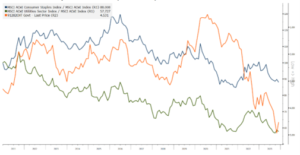Over recent weeks, the UK has experienced a spell of turbulent weather conditions, characterised by persistent rain and gusty winds. Amidst this turbulence, taking a break for a breath of fresh air has been refreshing. Notably, even my local beach in Scotland has undergone a transformation, temporarily becoming a surf destination.
Surfing serves as a fitting analogy for the evolution in markets that we are witnessing. Since 2009, we’ve been in an environment where central banks have exerted extensive efforts to mitigate volatility. This conditioning has led many investors to believe that markets are relatively predictable.
The regularity at which quantitative easing (QE) was used to smooth out the unexpected, such as the Euro crisis, or, more recently, COVID lockdowns, has become ingrained in data series, asset owner allocations and general investor psychology. In surfing terms, the markets had become an easy beach break suitable for beginners.
Suffice it to say, that game is over. The conducive swell that we all enjoyed for so long has now gone from the beach. The emergence of notable inflation has changed the game, as recovering lost credibility is now the paramount goal of central banks. As a reminder, US 10-year Treasuries yielded 0.508% in August 2020 and are yielding 4.6% as of writing. In the UK a similar punishing shift in the cost of borrowing has taken place, with 10-year gilts over the same period rising from a low of 0.077% to 4.29%. Borrowing costs in the US dollar, the world’s reserve currency, have risen 400 basis points. Translation costs for offshore borrowers have risen as a result of the higher dollar and credit lines may no longer even exist on renewal.
We are heading to a new beach that we have not surfed before and the situation is less predictable and a lot more gnarly. With the experimentation of QE and now quantitative tightening (QT) ongoing, this is new ground for policy makers and investors alike. We don’t know the final level of policy tightening needed from central banks, the timing (though recent market actions suggest it is nearing) or the duration of tight policy before a reversal may commence.
Hence investors continue to adjust portfolios for “higher for longer” and the challenges of slowing growth. Returning to the surfing analogy, 2023 has been all about picking the right board and finding the best and most consistent breaks on this newly discovered beach.
Picking the right spots in the market
The one thing we have been confident about throughout this year is that we have a trusted surfboard, our Future Quality philosophy. In our view, companies that can grow, attain and sustain superior returns on invested capital and have all the key quality pillars in place (Franchise, Management, Balance sheet and Valuation) are the best candidates for longer term alpha today as much as they have ever been.
However, picking the right spot on the beach to surf has proven to be a more erratic exercise than anticipated. Given the lower growth and higher cost of capital regime we expected, the spots we preferred at the beginning of the year were the following:
- Enablers of the required spending on energy transition: This has been correct overall with Chart Industries (sold in Q3), Schneider and Linde all proving to be winners for portfolios.
- Normalisation and structural growth in global travel: Booking Holdings, Amadeus and Samsonite have been positive contributors.
- Providers and enablers of Healthcare Efficiency: Incorrect so far, with the majority of holdings lagging the benchmark.
However, the best “breaks” have been at spots we didn’t expect. These have presented the biggest challenges, specifically:
- Technology leaders have become the defensive havens of choice: We had technology marked as an area of the market likely to face headwinds resulting from an end to the cheap capital era and a more challenging environment for customer spending. This element may still prove to be a correct concern over time, but other positive attributes have completely swamped this thesis and hence we were downright wrong from an allocation perspective.
The catalysts for the leading performance of larger tech names, particularly in the first half of 2023, are more obvious with hindsight—emergence of artificial intelligence (AI) as a dominant force, high cash flow generation, proactive cost cutting to support profitability and strong balance sheets. AI is in a period of rapid growth that is generally independent of the broader economic cycle. Moreover, the larger technology firms have the starting ingredients of large data sets, existing AI engineers and the ability to spend large amounts of capital. As a result, they are making the moats around their franchises deeper and wider. A degree of rerating from the depressed levels of late 2022 has hence been well deserved.
We had some exposure with holdings such as Microsoft and TSMC, but we didn’t have enough of the affectionately named “Magnificent 7”. Subsequently, we updated our research, forecast models and valuation analysis. As a result, there are now some names on reappraisal that now meet our Future Quality criteria. Over recent months, we added Synopsys, Nvidia, and more recently, Meta. All these market leaders are benefitting from the rapid adoption of AI. Whilst AI has an element of hype, it also has a high probability of being the game changing technology for the next generation, and the picks and shovels of the adoption phase will be leaders. The successful new business models or use cases of AI are an exciting area for our research. However, it is too early to define the winners, with the Internet bubble of the 2000s being one possible parallel.
Obesity-management drugs go mainstream…for the few
AI is not the only new kid on the block, with the successful regulatory approvals of GLP-1 obesity-management drugs boosting the growth potential of the leading providers Eli Lilly and Novo Nordisk. Given the hype surrounding these drugs, their valuations have surged. Novo Nordisk’s P/E, which was in line with the healthcare sector globally in 2019, today trades at a 72% premium.
The mirror image has been a notable de-rating of healthcare/consumer companies identified as GLP-1 losers. While the direction of thinking could be correct, it reminds us of the period when EV adoption was at peak frenzy back in 2020. During that time, some investors shorted auto parts-related companies, anticipating a quick depletion of cars needing repair. We bought O’Reilly Automotive when the market made that particular misjudgement and it has notably rewarded portfolio returns since. We wonder if a similar scenario will play out in the coming years with those businesses identified as GLP-1 losers. Hence, we continue to be happy holders of companies such as Abbott, Danaher and Bio-Techne.
Tough environment favours unique business models
We have shared our experience and how we are learning where the leaders are more likely to be in this new higher-cost-of-capital regime. We describe them through the lens of common themes as this provides an easier understanding for many investors. However, each and every company we own must meet the test of attaining and sustaining high returns on invested capital. Even better, we look for companies on a journey of sustainable improvement over the next five years—a tough journey at most times, and one made more difficult by the current economic headwinds.
These Future Quality paths are often rather unique to individual companies. Growing market share is one common characteristic of such companies, and we have already highlighted Meta as an addition, with the ongoing scale of global advertising share being a key positive for the company. Ryan Speciality is another example and an addition to the portfolio in recent months, where rising share in the wholesale insurance brokerage market in the US is a key driver for above-average growth in this high return business. Our other insurance holdings, Palomar and Progressive, have similar above-market growth reflecting their more unique business models.
Undercurrents in the current environment
Returning to the surfing analogy, the new beach we find ourselves on harbors persistent undercurrents demanding consideration. Capital needs stand out prominently: many investors remain conditioned by the last decade, an era of readily available and, for the most part, excessively cheap capital. However, the dynamics have shifted in public markets, and we anticipate a similar transformation in private markets as the pipeline of dry powder gradually diminishes.
Within listed equity markets, our observations reveal a widening risk premium between capital providers (currently experiencing a large excess of free cash returning to investors) and capital takers (facing insufficient profitability for self-financing growth or servicing debt providers). This expansion of risk premiums, driven by operating and refinancing risks, might have further room to evolve, especially when both risks are evident.
Pricing of low-volatility dividend yields
One of the features of the QE era was the search for low volatility yields in assets other than fixed interest, as the real yields were manipulated lower. There is a relationship therefore between the relative performance of these lower vol, higher dividend havens in the equity market, with consumer staples and utilities being suitable examples (Chart 1).
Chart 1: Consumer staples, utilities and 10-year US bond yields
Source: Bloomberg, November 2023
While they will undoubtedly retain some degree of haven status during periods of shorter-term crises, higher real bond yields are prompting investors to reconsider previous allocations to these companies. Moreover, higher term premiums are affecting valuations, as longer-duration debt on refinancing will require more cash flow allocation that will no longer be available for equity holders. In short, they are becoming less of the defensive haven of choice, and relatively cheaper valuations will likely persist or widen further until either real rates reverse, or asset owner reallocation dissipates as a driver.
Adapt to the conditions
The last few quarters have served as a good reminder that we are in a changing world. Interest rates have risen much more than most investors, including ourselves, expected. Geopolitics are signaling an end to the peace dividend that has prevailed for the careers of most financial players, with ongoing developments in the tinderbox of the Middle East being the current addition to ongoing uncertainty. Finally, we need to remind ourselves that QT has no notable precedent in the modern and highly leveraged financial world.
As a result, we need to focus always on investing in enduring franchises, and we believe that our Future Quality approach is soundly placed in that regard. However, valuation is also one of our pillars and still a key variable over shorter time horizons. Being on the wrong side of these widening valuation dispersions is painful, while also being a comfortable momentum tailwind for the areas of the market attracting investor attention. It is difficult to know when these rotational forces will become exhausted or be altered by subsequent events, but it is probably fair to assume we are a good way down that journey already.
Hence, we maintain that a significant amount of caution and discipline are needed when building positions in prior winners, being diligent about the risks of ‘better value.’ We also need to approach monetary policy with an open mind; sometime soon, central banks could change the game again by reversing rate hikes, ending QT, or even going straight to an era of financial repression. In short, be ready with your trusted surfboard and make the most of the conditions.
For more information on the Yarra Global Share Fund and if you would like to add it to your clients’ portfolio, please contact our distribution team.
The Yarra Global Share Fund is invested in the Nikko AM Global Equity Fund managed by the Global Equity Team of Nikko Asset Management Europe.



0 Comments